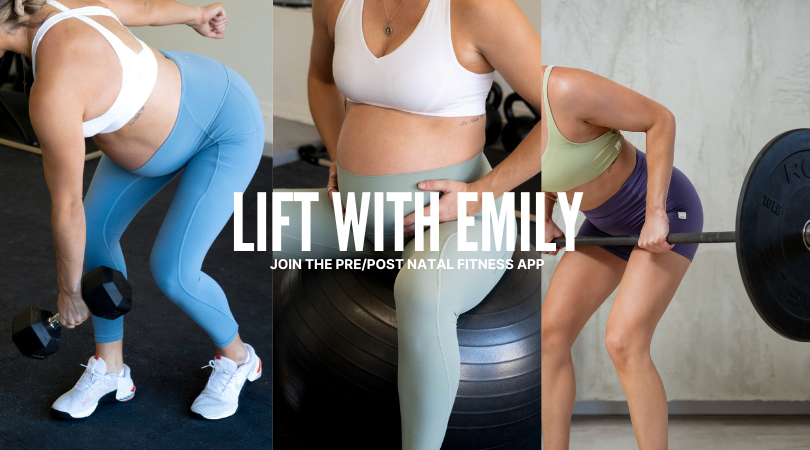Upper ab and rib gripping is a compensation pattern that can happen in the postpartum period. The tension created by the tendency to grip the upper abdominals can create downward pressure in lower abs and pelvic floor. In order to heal things like a Diastasis Recti, we need a balance of all of these muscles to help better manage intraabdominal pressure.
Are you an upper ab gripper?
Here are some signs you may be. Do you:
- Notice your lower abs stick out more than your upper? (It’s important to note that we all have uterus’ so your low abdominals are not always going to be perfectly flat)
- See a crease above your belly button? Or are your upper abs are more defined compared to your lower?
- Can you zip up your abs from the pubis/crotch without your upper abs firing?
- When you exhale really hard, do your lower abs push out vs flatten?
- Do you just feel yourself sucking in your abs when standing? Whether unconsciously or consciously if trying to appear smaller. Or notice yourself clenching your glutes throughout the day?
If yes to any or all of the above, then you might have a tendency to grip your upper abs.
Why do we want to address upper ab gripping?
Your muscles also need a work/rest cycle, and your core is not meant to be in a contracted state the entire time. If your muscles are in a constant contracted state they are always on and in a shortened position, which makes it very hard for them to get stronger.
It makes diaphragmatic breathing harder as it forces you to take more shallow breaths since there is less movement in that area. This mean you are not getting the full benefits that come with diaphragmatic breathing. This in turn means that when we ask something of them when performing things like a heavy deadlift or a high pressure core exercise they struggle to respond and manage the increase in intra-abdominal pressure. That pressure has to go somewhere and it’s usually forward on the abdominal wall or down into the pelvic bowl. This pressure can increase pelvic floor symptoms like urinary incontinence, hemorrhoids, back pain, pelvic floor tension or increased prolapse symptoms.
How can you correct?
Skin rolling: a form of myofascial release. A technique used to identify and treat any areas of restrictions in the fascia on connective tissue. Healthy fascia is like a spider web and is pliable and moveable. When restricted, it loses this pliability and can become ‘sticky’ and result in loss of motion in that area. Skin rolling can help break these sticky points and restore more mobility in the fascia.
To perform, pinch the skin between the fingers and pull the skin away from your body. Move along your upper abs continuously picking up the skin to stretch and mobilize the fascia.You may notice some areas of your middle and upper abs are more restricted than others.
Back body and lateral rib expansion: Work on your rib cage expansion and use your breath to mobilize from the inside out. Lying side ways on a yoga block and diaphragmatically breathing is a great way to restrict one side of your ribs to allow your breath to travel to the opposite side to get more movement in your ribs. The same technique can be applied to help breathe into the back of your body (specifically you thoracic/bra line). By rounding forward, or folding over a yoga block, pilates ball or pillow, you’re restricting the breath to the front side to encourage it to move back.
Actively relax your lower abs: a great position to do this in is on your hands and knees. In this position you can use gravity to assist in letting go. In this position, take deep inhales feeling yourself let go with each breath.
Mobilize your upper back: your thoracic spine needs to move. The ribs attach to the thoracic spine, so if your spine isn’t moving well the ribs are affected. If it lacks mobility, your rib cage will struggle to create more space for your diaphragm to expand as you inhale. This then affects your core strength and pelvic health.
Practice engaging your lower abdominals without firing your upper abs: this can be really hard for a lot of people. This side lying knee lift is one of my favourites to really isolate the lower abs and work on lower abdominal strength while maintaining a stable pelvis.
Focus on these approaches first and see if your habits improve. If you are struggling to see improvements, I encourage you to seek help from a pelvic floor physical therapist and work with me 1:1 for a more personalized approach to your strength training.

I’m deeply passionate about helping women feel strong, informed, and confident through every stage of motherhood. You deserve more than just a list of do’s and don’ts or generic modifications. With years of hands-on coaching across all kinds of athletes and clients, I blend real-world experience with specialized pre and postnatal knowledge to create strength programs that go far beyond basic adjustments. This is high-level, accessible training - built for your body, your season, and your goals
EXPLORE MORE POSTS